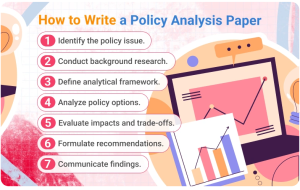How to Write a Policy Analysis Paper
How to Write a Policy Analysis Paper
In this section, we’ll cover the basics of writing a policy analysis paper. This type of paper involves breaking down complicated policy issues, figuring out how well they’re working, and suggesting ways to make them better. We’ll walk you through the steps, like defining the goals of the implementation, looking at how it’s being put into action, and checking what effects it’s having. By the end, you’ll have the skills to write a clear, well-reasoned paper that can help shape policies for the better. 
Understanding the Policy Issue
Start by thoroughly understanding the policy issue or problem you’re analyzing. Research its background, context, and significance. Identify key stakeholders, relevant laws or regulations, and any existing policies addressing the issue.
Defining the Scope and Purpose
Clearly define the scope and purpose of your analysis. Determine what specific aspect of the approach you’ll focus on and why it’s important. Clarify the goals of your analysis and what you hope to achieve with your paper. Use an expert english essay writing service to streamline your effort in producing a first-class paper.
Gathering Data and Evidence
Collect relevant data and evidence to support your analysis. This may include statistical information, case studies, expert opinions, and academic research. Use credible sources and ensure your data is accurate and up-to-date.
Analyzing the Policy
A policy analysis paper evaluates the legislative program’s effectiveness, strengths, weaknesses, and implications. Use a structured approach, such as a SWOT analysis (Strengths, Weaknesses, Opportunities, Threats) or cost-benefit analysis, to assess the procedure from multiple perspectives. Consider its intended goals, implementation strategies, outcomes, and unintended consequences. If you need help with SWOT analysis, using our analytical essay writing service is highly recommended.
Developing Recommendations
Based on your analysis, develop clear and actionable recommendations for policymakers or stakeholders. Identify specific changes or improvements that could enhance the system’s effectiveness or address its shortcomings. Support your recommendations with evidence and reasoning.
Writing and Communicating Your Analysis
Organize your analysis into a coherent and persuasive paper. Structure your paper with an introduction, background information, analysis, recommendations, and conclusion. Use clear and concise language, avoiding jargon or technical terms unless necessary. Provide citations for your sources and evidence. Finally, ensure your paper is well-written, logically organized, and effectively communicates your insights and recommendations.
Policy Analysis Paper Example
A policy analysis paper example serves as a valuable learning tool for students by providing a concrete model to follow and reference when undertaking their own analysis assignments. By studying an example paper, students can gain insights into the structure, content, and methodology of analysis, helping them understand how to effectively frame their analysis, support their arguments with evidence, and formulate actionable recommendations.
Example 1: “Implementing Universal Basic Income”
This policy analysis paper examines the feasibility and potential impacts of implementing a Universal Basic Income (UBI) program in the United States. It explores various options for UBI design, including cost and financing considerations, labor market effects, poverty reduction potential, and administrative feasibility. By reviewing existing evidence and debates surrounding UBI, the paper aims to provide a comprehensive understanding of the opportunities and challenges associated with adopting such a program, ultimately highlighting the need for careful analysis, experimentation, and stakeholder engagement in shaping effective UBI policies.
Example 2: “Addressing Climate Change through Carbon Pricing”
This policy analysis paper examines the role of carbon pricing policies in addressing climate change, evaluating their efficacy, implementation challenges, and potential impacts. Carbon pricing mechanisms, including carbon taxes and cap-and-trade systems, aim to internalize the external costs of carbon emissions and incentivize emission reductions. The paper discusses the economic efficiency of carbon pricing in promoting innovation and investment in clean technologies while also addressing equity considerations regarding its distributional impacts on low-income households and vulnerable communities.
Summary
Writing a policy analysis paper is super important for students because it helps them learn how to tackle tough societal problems and make smart decisions. You get to sharpen your thinking skills, learn how to research thoroughly and become better at expressing yourself clearly. Plus, writing these papers helps students practice effectively communicating their ideas, which is a skill they’ll need in their future careers, whether they work in government, nonprofits, or elsewhere. By digging into real-world issues, students also get a better grip on how politics, economics, and society all fit together. If you’re not committed to handling this task yourself, instruct our experts, saying, ‘write my essay,’ and receive the most competent help within hours.
Source:
